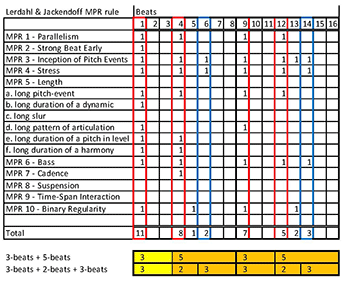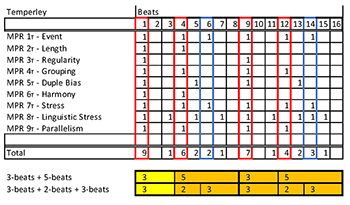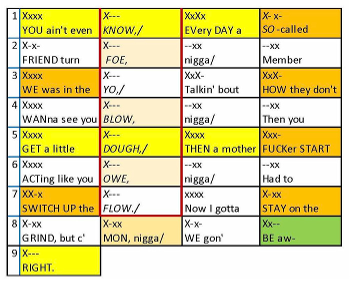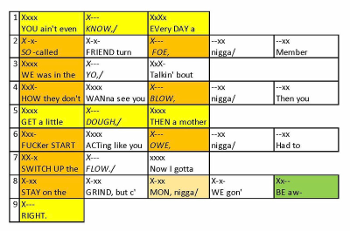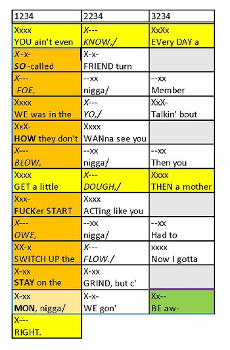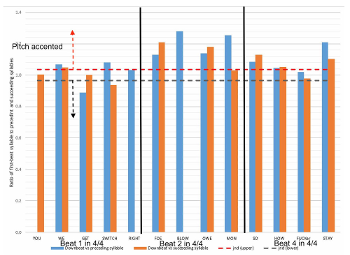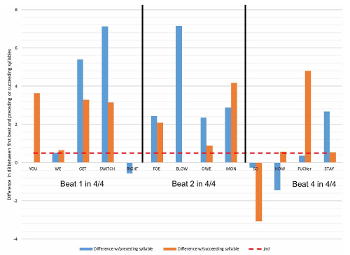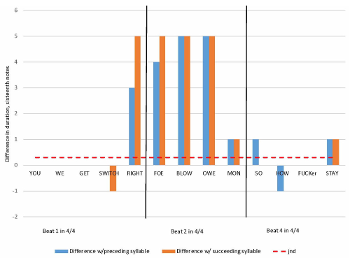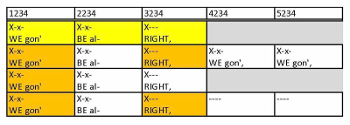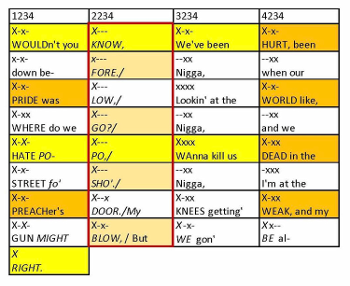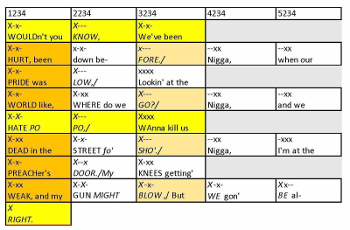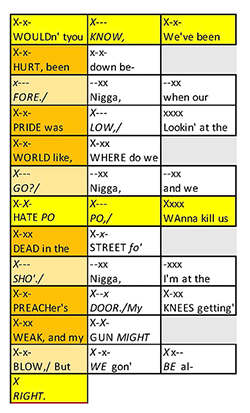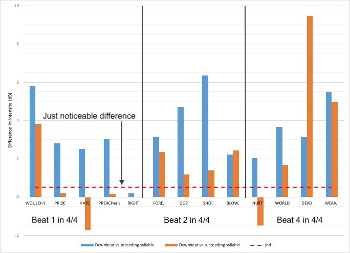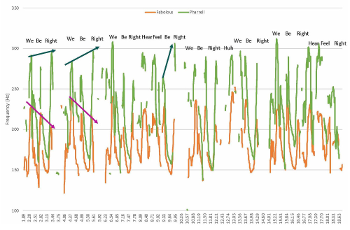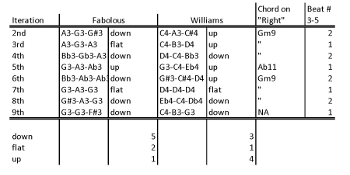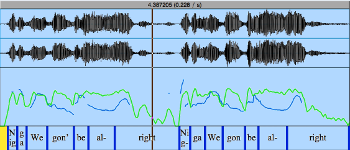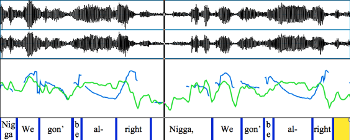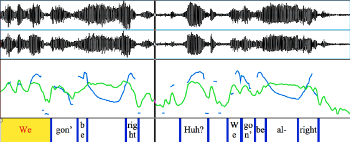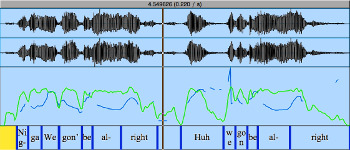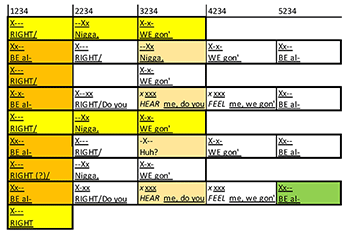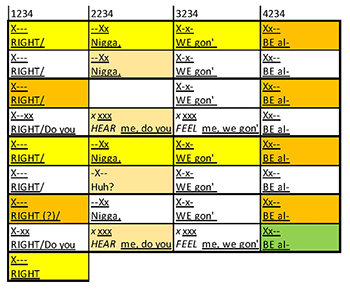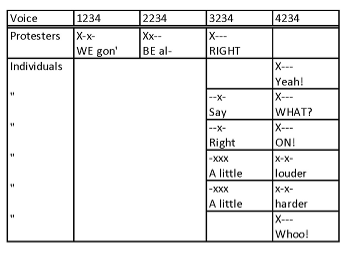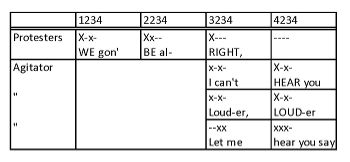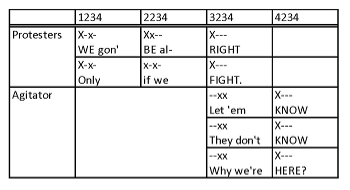We Gon’ Be Alright? The Ambiguities of Kendrick Lamar’s Protest Anthem*
Noriko Manabe
KEYWORDS: Rap music, hip hop, flow, meter, intonation, vocal pitch, protest music, protest chants, African American English
ABSTRACT: The best-known track on Kendrick Lamar’s To Pimp a Butterfly, “Alright” has come to be regarded as a protest anthem, fueled by Lamar’s charged performances of the song at the BET Awards and the Grammys, and by accolades from the press that cite its political importance. This article argues that the actual musical track is ambiguous and open to several interpretations. To support this idea, I first explore the process through which the track came into being and how this process may have contributed to the song’s ambiguity. I then examine the message of “Alright,” contextualizing its place in the concept album and in the music video. I closely examine the musical track, analyzing its accent patterns using the metrical preference rules of Lerdahl and Jackendoff (1983) and David Temperley (2001). This analysis of the track implies a 3+5 or 3+2+3 beat reading of the meter in addition to a straight
DOI: 10.30535/mto.25.1.9
Copyright © 2019 Society for Music Theory
1. Introduction
[1.1] “Alright” is perhaps the best-known song from Kendrick Lamar’s To Pimp a Butterfly. It has garnered numerous accolades, including Best Rap Song and Best Rap Performance at the 2016 Grammys (Rolling Stone 2016) and several best-of-2015 lists.(1) Much of the praise stems from the song’s political import. In its summary of the song for the Best Hip-Hop Songs list, Billboard notes its presence in Black Lives Matter and the Million Man March, adding, “it would be criminal to overlook the social struggle that K.Dot [Lamar] captured from the frontlines with ‘Alright’” (Platon and Rhys 2015). As Matthew Schnipper (2015) notes in Pitchfork, “It has soundtracked a movement.” Generally interpreted as a message of hope during a dark time, the song has been called the “unofficial anthem of the Black Lives Matter movement”(O’Connor 2017), the “New Black National Anthem” to replace “Lift Every Voice and Sing” (Harris 2015) and this generation’s “We Shall Overcome,” making it “the most important rap record of the decade so far” (Garrett 2015).
[1.2] Yet some listeners have noticed a sense of ambiguity in the song. As one blogger wrote, “on ‘Alright’ Kendrick attempts to pick himself back up, with a distinctly unconvincing tone” (Prof 2015, emphasis mine). Jayson Greene (2015) of Pitchfork commented, “[Pharrell Williams, who raps the hook,] doesn’t sound
[1.3] This article discusses the ambiguities inherent in “Alright.” The narrative of strength and hope that “Alright” takes on in the context of the album, video, and Lamar’s performances contrasts with its sonic qualities—an ambiguous meter and questioning intonation in the hook, as originally constructed and performed by Williams. The multiplicity of sonic, visual, and paratextual inputs provides the potential for conflicting interpretations, yet the public has chosen the “we strong” interpretation (Lamar’s words), as evidenced by the song’s adoption in protests. I begin by discussing the meaning of the lyrics within the context of the entire album, and the ways in which the music video and Lamar’s performances have highlighted a few aspects of the lyrics, shifting the meaning of the song. After setting up the analysis with preliminary discussions of metrical preference rules and choice of tactus, I examine the ambiguities in the musical track by comparing two potentially different metrical interpretations—
2. The process of the song’s creation
[2.1] Like many hip hop tracks, “Alright” did not come together overnight, but through a series of iterations and contributions from different people. Pharrell Williams produced the original version of the track and gave it to the rapper Fabolous, who added a rap track. Williams previewed Fabolous’s version at the Fool’s Gold Rap Party in January 2014—over a year before Butterfly was released. Sometime after this party, Williams was persuaded to play the loop for Lamar and Sounwave, who decided to record their own version. Sounwave later added drums and saxophone to the original track. As he puts it:
[The “Alright” beat] was there, but it was not all there, vibe-wise, so that was my job to layer in the drums, get Terrace [Martin] to throw some sax riffs on it, and make it us. It’s a completely different song than the original. . . . You just have to have your ears open for every little sound that has potential (Bowman 2015, emphasis mine).
[2.2] In the meantime, Lamar developed writer’s block on the song. As he told Rick Rubin, the co-founder of Def Jam Records, in a GQ interview:
I was sitting on that record for about six months . . . . I knew it was a great record—I just was trying to find the space to approach it. I mean, the beat sounds fun, but there’s something else inside of them chords that Pharrell put down that feels like—it can be more of a statement rather than a tune. So with Pharrell and Sam [Taylor] asking me—Am I gonna rock on it? When I’m gonna rock on it?—it put the pressure on me to challenge myself. To actually think and focus on something that could be a staple in hip hop. And eventually, I came across it. Eventually, I found the right words . . . . I remember hitting P [Pharrell Williams] on a text like, Man, I got the lyrics. And typing the lyrics to him. He’s like, That’s it (Gwizdowski 2016).
[2.3] Before Lamar began working on the tune, the famous hook, “We gon’ be alright,” had already been formulated; as Lamar says in the GQ interview, “P[harrell] had the alright. That’s him on the hook” (Gwizdowski 2016). Williams is famous for his catchy hooks, which he often sings or raps on his productions.(2) He also sang the hook on his previous production with Lamar, “good kid,” in good kid, m.A.A.d. city. Hence, it is most likely that Williams formulated this hook rather than Fabolous.
[2.4] The preexisting hook forced Lamar to fit his verses into a narrative that fit Williams’s hook. As he explained, “And just saying the alright phrase—what does We are gonna be alright represent?” While Lamar claims that he was not aiming to make a protest song, he would have been writing in mid-2014, when the protests over Michael Brown, Eric Garner, and others were heating up; as he noted, “it was a lot going on.” He decided to take an approach that was “more uplifting—but aggressive. Not playing the victim, but still having that We strong, you know?” (Gwizdowski 2016). He acknowledged the hook for inspiring the deeper meaning: “I’m glad that sparked the idea, ‘cause that song coulda went a thousand other ways” (Gwizdowski 2016). On June 12, 2015—three months after the release of Lamar’s album, but just prior to the release of “Alright” as a single—Fabolous released his version of “Awwright.” (World Star Hip Hop 2015).
3. The Narrative of “Alright”
“Alright” in the context of the album
[3.1] To understand the meaning of the lyrics behind “Alright,” one needs to consider them in the context of To Pimp a Butterfly. The album tells the story of Lamar coming to terms with material success, contemplating his relationship with his hood, reconnecting with his values, reaccepting himself with love, and assuming a leadership role. As analyzed in the other essays of this forum, the songs offer varied angles on race and the African American condition, including colorism (“Complexion”) and racism (“The Blacker the Berry”).
[3.2] The concept is encapsulated in a story Lamar reads to the legendary deceased rapper Tupac Shakur, who has been resurrected via a taped interview in “Mortal Man,”(3) the last track on the album. In it, he outlines the metaphors central to the album:
- The caterpillar, “a prisoner to the streets that conceived it / Its only job is to eat or consume everything around it”—e.g., a hood denizen;
- The butterfly, “the talent, the thoughtfulness / And the beauty within the caterpillar”—e.g., the artist in Lamar, the talent in the hoodrat;
- The pimp, in which the caterpillar sells out the butterfly to its own benefit; and
- The cocoon, an encasing that “institutionalizes him” and traps him so that “He can no longer see past his own thoughts”—i.e., institutionalized racism, the structures that support it, and social and psychological pressures that prevent one from breaking free.
Eventually, “Wings begin to emerge, breaking the cycle of feeling stagnant / Finally free, the butterfly sheds light on situations / That the caterpillar never considered, ending the internal struggle.” The concepts behind these metaphors of the pimp, the consuming caterpillar, the cocoon, and the free butterfly appear in varying degrees across all songs of Butterfly.(4)
[3.3] The narrative of the album is also summarized in the poem that Lamar reads between the songs (“I remember you was conflicted”).(5) He adds a few lines with each reading, ending with a line that points to the next song. He reads the poem in its entirety in the outro to “Mortal Man.”(6) The poem describes a conflicted man, “misusing your influence,” depressed and tempted by vices, who regains perspective and encourages members of his community to respect each other.
[3.4] “Alright” appears about a third of the way into the album, before the protagonist has reached his butterfly phase. The first three tracks address Lamar’s resistance to being pimped by the music industry and its expectations. In the first track, “Wesley’s Theory,” a new rap artist is being pimped in pursuit of materialism, presented to him by the character, Uncle Sam; being a caterpillar, the rapper embraces it.(7) The second, “For Free?,” finds Lamar resisting being pimped by the materialistic demands of a woman, possibly a metaphor for the expectations of the music industry. In the third, “King Kunta,” he returns to Compton in a swagger that he “run[s] the game” but “everybody”—perhaps the industry, perhaps the metaphorical slaveholders of the American middle class—“want[s] to cut the legs off him.”(8)
[3.5] The next three tracks picture Lamar trapped in cocoons. The fourth track, “Institutionalized,” finds him trapped in the ghetto mentality. In “These Walls”—the walls of a vagina, a prison, or one’s mind—Lamar has revenge sex with the baby mama of the man who killed his friend,(9) while recognizing that he was “abusing my power so you [the murderer] can hurt.” The feelings of guilt climax in “u,” a searing deluge of self-hatred as Lamar imagines the people of Compton blaming him for not being there for his pregnant teenage sister and a friend who died of gunshots. He can neither escape the expectations of his community nor deal with being alienated from the people there. Suicidally depressed, he drowns himself in alcohol in a hotel room. The refrain, “Loving you is complicated”—mockingly recited in a huge pitch range (from B2 to D5)(10) — taunts him like an inner demon until he passes out at the end of the track.
The lyrics of “Alright”
[3.6] Coming after such a turbulent track, “Alright” cannot help but sound uplifting. With its gospel-like multipart chorus and assurances that “we gon’ be alright” with God on one’s side, it sounds like a Sunday-morning epiphany, perhaps even a church service, after a particularly debauched Saturday night. The echo added to the word “alright” on Lamar’s “alright” and to Williams’ fourth “alright” gives it a godlike, supernatural quality, while the jazz chords in the chorus and jazz timbres in the saxophone and piano lend the track an air of urban sophistication.(11)
Table 1. Form of “Alright,” Kendrick Lamar and Pharrell Williams
(click to enlarge)
[3.7] Table 1 outlines the form of the track. The central theme of struggle is introduced at the outset with the quote, “Alls my life I has to fight,” from Alice Walker’s The Color Purple.(12) Many of the struggles that Lamar addresses in his verses are personal—the caterpillar’s materialism, in the form of painkillers, sex, and money. By the last four lines of the first verse, he seems content to be drowning in his vices, mock-singing that “it’s too late” and that he’s “gone cray.” The second verse finds himself reaching for redemption. He introduces Lucy (named as Lucifer in the music video) as temptress, quoting Uncle Sam’s exact same lines from “Wesley’s Theory,” the opening track:
What you want you: a house or a car?
Forty acres and a mule? A piano, a guitar?
Anything, see my name is Lucy, I’m your dog
Motherfucker, you can live at the mall.
In “Wesley’s Theory,” Uncle Sam may represent American capitalism, for whom Lamar is “the dollar in you,” and encourages him to spend his money; Uncle Sam may also stand for the government, empowered to give suddenly rich African Americans like Wesley Snipes their comeuppance (through a conviction for tax fraud, in Snipes’s case). Through quotation, Lamar equates Lucy as temptress-devil with Uncle Sam, drawing parallels between American capitalism and consumerism, on one hand, and evil and social oppression, on the other. The phrase “forty acres and a mule” refers to promises of land ownership made but largely unfulfilled to former slaves after the Civil War; it indexes the song to the history of oppression of African Americans and the unkept promises that society has made to them. Hence, materialism is another “forty acres and a mule,” a false promise that will not bring personal happiness or socio-political parity. Lamar recognizes the evil (“I can see the evil”) and the unlimited nature of material wants (“ain’t a profit big enough to feed you”). He eventually regains control by trusting in God (“Heaven, I can reach you,” “I write ’til I’m right with God”). It is one inflection point in the album, at which Lamar rejects the caterpillar mentality and takes a step toward his transformation into a butterfly. As in much of his oeuvre, Lamar thus calls on inner strength as a way of dealing with the state domination and systemic forces that are hostile to black bodies (Love 2016).(13)
[3.8] A few lines also reference contemporary concerns. Lamar’s lyrics were likely written in mid-2014, a time of Black Lives Matter protests following the police’s killing of Eric Garner on July 14, 2014, and Michael Brown on August 5, 2014. In Compton, police brutality has long been extant, exacerbated by the war on drugs and the militarization of the police, and it is a common topic among South Central Los Angeles rappers, most famously NWA’s “Fuck the Police” (Kelley 1996; Kajikawa 2015). No stranger to police use of excessive force, Lamar had previously recounted his personal experience with the police in the track, “good kid” (2012), about the challenges of growing up harassed by gang members, profiled by the police, and surrounded by drugs.(14) As he explained in a self-penned essay in XXL:
The past few years or so have been very politically charged and controversial. From Trayvon Martin, to Eric Garner to Michael Brown and issues of police brutality and racism and for so many other reasons. All of it has really struck a nerve with me because when you experience things like that personally and you know the type of hardships and pain that it brings first-hand, it builds a certain rage in you. It brings back memories of when I’m 16 and the police come kicking the door in. They don’t care that I’m a little boy and they stumped me in my back two times and they dragged me out the house and have us all handcuffed. It brings back those memories (Lamar 2015a).
[3.9] Several lines in “Alright” allude to police violence. The line, “homicide be looking at you from the face down,” refers to a murdered black person, possibly killed by the police. He asks, “What MAC-11 even boom with the bass down?,”(15) possibly referring to the underreporting of police (or community) violence. Most directly, Lamar raps in the pre-hook, “And we hate po-po / Wanna kill us dead in the street fo’ sho’.” As “po-po” is a term for “police,” the line refers directly to police brutality and connects the song with the Black Lives Matter movement. The song closes as Lamar comes to terms, if tentatively, with the demons of “u.” While acknowledging his fears, he resolves the refrain, “Lovin’ me is complicated,” by the repetition of stabilizing descending triads.(16) Anticipating the self-love anthem of “i,” he accepts himself: “I’m alright, and you’re a favorite.”
Performances and videos
[3.10] More than the lyrics themselves, it is the paratext of visuals in the form of performances and the music video that has connected “Alright” with police brutality. On June 28, 2015, Lamar caused a controversy at the BET Awards when he performed the song on top of a police car, backed by an enormous projection of a tattered American flag. The symbolism of a police car, conquered by hip hop graffiti and serving as a stage for an African American star, was evidently too much for Geraldo Rivera, who grumbled on Fox News: “This is why I say that hip hop has done more damage to young African Americans than racism.” Lamar retorted on TMZ that the song was about hope, not hatred, and refocused the problem on the reality of police brutality rather than on the way it was being expressed in hip hop (Williams B 2015).
[3.11] Two days later, the music video of “Alright” was released, confirming the themes of police brutality and hope (KendrickLamarVEVO 2015). The video begins with a long introduction, showing scenes from Oakland, home of the Black Panthers and site of fraught relations between the black community and the police; the scream at the beginning of “u” is heard, as well as the poem, as it is heard at the end of “Hood Politics” and beginning of “How Much a Dollar Cost.” Helicopters are overhead, a boy is chased by gangs, a car is on fire, and a white policeman shoots a black man, the bullet shown exiting the barrel of the gun in slow motion.(17) Then Lamar and his fellow rappers from Black Hippy(18) are in a car, rocking to a song that Lamar and Sounwave wrote for the video.(19) The camera pans out, showing four white policemen carrying the car on their shoulders. This image could be interpreted several ways. One writer believes it is a play on “King Kunta,” with the police carrying the new royalty on litters (Phillips 2015). On the other hand, the police could be seen as pallbearers carrying a coffin, symbolizing their disproportionate impact on black lives. Lamar’s words seem to support the latter interpretation, as he bids R.I.P. to a friend and vows, “My diligence is only meant to write your eulogy.”
[3.12] Once the song starts, the video gets progressively lighter in feel, propelled by the joyous sight of people dancing. Light, too, is Lamar himself, who floats in the air like a guardian angel; unlike the angels in works like Wim Wenders’s Wings of Desire (1987), however, people can actually see him. They marvel at him; to them, he is a superhero. At the end of the video, he is rapping on top of a light pole in Los Angeles to a large crowd, when a white policeman shoots him down with two fingers—symbolic of the fact that hegemonic powers do not need a gun to bring black men, even superheroes, back down to earth. Lamar bleeds, falls, and lands on the ground. The screen goes black, and we assume he is dead; then the camera shows a close-up of his face, smiling. According to Colin Tilley, the director of the video, “he’s really saying, ‘Everything is still gonna be alright.’” Yet his explanation is conflicting: “[The ending] showed that nobody’s invincible, no matter what you do or who you are, it could happen to anybody” (Tardio 2015).
[3.13] Lamar’s performance at the 2016 Grammy Awards further cemented the narrative that “Alright” was a political song and that Lamar was a political rapper. He came onstage as one of a group of chained convicts in prison, a reference to the mass incarceration of African Americans. He rapped “The Blacker the Berry,” an angry track about institutionalized racism from the album,(20) with not much more accompaniment than a saxophone, before transitioning into a performance of “Alright” around a bonfire, a melding of the celebratory aspects of the track with an imagined Africa. According to Africanist Salim Faraji, Lamar thus pointed out that “Africa is in Compton and Compton is in Africa”—that is, that the struggle for racial equality in the U.S. is “more precisely a battle for the assertion of African power,” a pan-Africanist philosophy embraced by Kwame Ture and other activist leaders of the 1960s–70s (Faraji 2016, 3–4). Perhaps the most direct tie to Black Lives Matter was an unreleased rap he performed at the end, referring to Trayvon Martin: “On February 26th I lost my life too
4. Preliminary considerations in analyzing the meter of “Alright”
Must rap be in
[4.1] A major source of ambiguity in “Alright” is the meter, which can be interpreted in ways other than a straight
Can one use metrical preference rules in hip hop?
[4.2] To show that “Alright” has atypical accentual patterns for a
[4.3] While both sets of authors developed their models using Western classical music repertoire, they also believe that aspects of this preference system are applicable to other kinds of music, making the model potentially useful for sorting out local detail and identifying points of relative stress (Lerdahl and Jackendoff 1983, 96). To open the possibility of applying the rules to other musical idioms, Lerdahl and Jackendoff give a brief example of Macedonian and Bulgarian folk music, which tends to be in additive meters. David Temperley (1999, 2001) applies his metrical preference rules to rock and African music.(26)
[4.4] In my experience, the MPRs of Lerdahl and Jackendoff, as well as of Temperley, work well for rock, pop, and hip hop, much of whose harmonic and metric structures have roots in Western music. I have found that the most important of Lerdahl and Jackendoff’s MPRs for determining meter in hip hop are the long duration of a harmony (MPR 5f) and a stable bass (MPR 6), followed by the inception of long pitch events (MPR 3), corresponding to MPR 6T (harmony) and MPR 2T (length) in Temperley. These rules reflect the ways in which rappers determine their flow: they usually listen to the bass or drums as a guide, sometimes substituted for a keyboard or guitar. As Big Pooh of hip hop group Little Brother told Paul Edwards, “Whether it’s the bass line or it’s drums or a piano, I always end up picking out something that I use as my guide” (Edwards 2009, 115). And while producers like Pete Rock regard the drums as foundational (Manabe 2008), many rappers find the bass to be the key factor. As rapper Gift of Gab from hip hop duo Blackalicious says, “I’m basically trying to be like another instrument on the track. I want to ride it like the bass line is riding it” (Edwards 2009, 115). Hence, the bass, and by extension, harmonies, are an important determinant of flow and the perception of rhythm.
What is the tactus for “Alright”?
[4.5] In order to apply MPRs and analyze the metric patterns of “Alright,” one must first identify the tactus. Justin London notes that the tactus is the level of pulse that anchors the metric hierarchy (2012, 30–33). Lerdahl and Jackendoff define tactus as “one specially designated metrical level
[4.6] In “Alright,” this tactus would make the loop sixteen beats long (ca. 0:19–0:28), at a tempo of 112 beats per minute (bpm). It would correspond to the pulse of the four repeating chords at the beginning of the track, which is Williams’s signature introduction, as well as the constant hits on the hi-hat. It also results in an interval of 536 milliseconds (ms) from beat to beat, which, per London (2012, 57), is in the zone of 500–700 ms periodicity (120–86 bpm) upon which humans prefer to hear beats.(27) Taking this 536 ms interval to be the quarter note, the eighth notes (corresponding to the speed of “We gon’” in “Alright”) would be at 268 ms, a threshold speed at which we can still feel a beat; the sixteenth notes would be 134 ms, approaching the 120 ms limit for comprehending vocal articulation (London 2012, 27–35). Note that the sixteenth note is the shortest unit that is frequently and consistently used in the track; this would argue against the half note, at 56 bpm, as the tactus, as the eight subdivisions (consisting of the sixteenth notes) would exceed London’s limit of six. Hence, the 536-ms interval is the most sensible tactus and quarter note.(28)
5. Applying metrical preference rules to “Alright”: a 3+5 configuration
Table 2. “Alright,” hook, MPR chart per Lerdahl and Jackendoff (1983)
(click to enlarge)
[5.1] Having determined the tactus, I now analyze the meter of “Alright” using MPRs. Table 2 shows an analysis of the loop at the first instance of the hook (0:19–0:38), using Lerdahl and Jackendoff’s MPRs, with the horizontal axis representing the sixteen quarter notes of the complete loop. Table 3 shows the same analysis using Temperley’s MPRs. The most stressed beats are boxed in red, while secondary stresses are boxed in blue; the resulting patterns are given below the main table, with the beats of the
Table 3. Table 3. “Alright,” hook, MPR chart, per Temperley (2001) (click to enlarge) | Example 1. “Alright,” instrumental loop, 0:19–0:36 (click to enlarge, see the rest, and listen) |
[5.2] For both MPR charts, a “1” is marked each time a rule is relevant to that beat, and a sum is taken at the bottom. In both analyses, the first beat has the highest MPR sum. Its accent is strengthened by being the first beat (MPR 2 in Lerdahl and Jackendoff, MPR 4T in Temperley); this “one” is signaled on the beats preceding it by the drums, which play a typical pre-cadence pattern. Beat 1 is made particularly strong because of the change in harmony to
Example 2. “Alright,” drums, 0:19–0:36
(click to enlarge and listen)
[5.3] The next most accented beat is beat 4, stressed by the change in harmony to Gm9 (MPR 5f, MPR 6T), the long bass note (MPR 6, MPR 2T), and the change in note in the trumpet (MPR 5a, MPR 1T). Furthermore, the move to the Gm9 is heard as a cadence, and to keep the cadence more metrically stable (MPR 7), one could be inclined to hear beat 4 as a downbeat to a second measure. In contrast, the drum pattern repeats in a
[5.4] The next accented note occurs on beat 6, due to the stress of the half-note chord (MPR 4, MPR 7T, MPR 1T).(30) This accent is less pronounced than the ones on beat 1 or beat 4, however, as there is no change in the chord (Gm9). Hence, the accent pattern of the first eight beats are 1-2-3-4-5-6-7-8, with 6 weaker than 1 and 4. In terms of measures, it could be interpreted as one measure of 3 beats followed by one measure of 5 beats, or a pattern of 3 beats, 2 beats, and 3 beats. This pattern is repeated in beats 9–16, where the accented beats are 9, 12, and 14, with beats 9 and 12 stronger than beat 14. While still pronounced, the accents for the second half are not as strong as the ones in beats 1–8, as there is no change in harmony; it remains at Gm9. Hence, the entire loop of 16 beats is subdivided into two sets of 8 beats, each with 3+5 beats or 3+2+3 beats.
[5.5] To test the feasibility of this interpretation, I compared it against Justin London’s well-formedness constraints (WFCs) for meters and found that it fits them.(31) Taking the 16-beat loop to be two 8-cycles of quarter notes, the interonset intervals between attentional peaks (for this example, the quarter notes) on the 8-cycle are greater than 100 ms (WFC 1.1); these attentional peaks are at 536 ms, between the 400–1,200 ms range (WFC 1.2); it has a beat cycle (WFC2) that is continuous (WFC3) with the same period duration; and subcycles (i.e., higher levels with longer interonset intervals, in this case the 3+5-beat and 3+2+3-beat configurations) connect nonadjacent time points in the next lowest cycle (WFC 3.4; London 2012, 92).
[5.6] For non-isochronous meters, London (2012, 128–9) imposes an additional constraint of maximal evenness, or patterns distributed as evenly as possible. With this rule, the 3+2+3-beat reading would fit better with London’s constraints. He does acknowledge that a 3+5 beat is possible (even though it is not maximally even) at tempos where the interonset interval is 115–150 ms, which is shorter than the quarter note in “Alright” (at 536 ms). As I will illustrate, the clauses (containing a subject and predicate) of the rapper’s lyrics often fit better into the 3+5 scheme, while the verbal accents fit the 3+2+3 scheme.
6. Rappers’ interpretations of the meter in “Alright”
Table 4. Fabolous, “Awwright,” form
(click to enlarge)
Example 3. Fabolous, “Awwright,” pre-hook in 4/4, 0:00–0:19
(click to enlarge and listen)
Example 4. Fabolous, “Awwright,” prehook as 3+5-beats (0:02)
(click to enlarge and listen)
Example 5. Fabolous, “Awwright,” pre-hook (0:02), 3+2+3 beats
(click to enlarge and listen)
Example 6a. Fabolous, pre-hook, beat 1 in a 3+2+3 grouping, difference in pitch with neighboring syllable (ratio)
(click to enlarge)
[6.1] What deepens the sense of ambiguity in “Alright” is that aspects of the track support a
Meter in Fabolous’s “Awwright”
[6.2] Fabolous’s rap reflects both the
[6.3] Fabolous’s rhymes align on the same beat in a
You ain’t even know (2 beats)
Every day a so-called friend turn foe, nigga(32) (5 beats)
‘Member we was in the yo (3 beats)
Talkin’ ‘bout how they don’t wanna see you blow, nigga (5 beats)
[6.4] After the first clause, Fabolous raps these lines so that the first beat of each clause acts as a pickup, corresponding to beat 3 in a 3-beat measure or beat 5 in a 5-beat measure. With this consistent offset of one pickup measure, Fabolous’s clauses each fit into a measure in a 3-beat, 5-beat scheme (Example 4).
[6.5] Example 5 shows Fabolous’s pre-chorus set in a 3+2+3 scheme. Typically, English speakers accent syllables by pitch, volume, and duration. In order to assess Fabolous’s accents by pitch and volume with greater accuracy, Fabolous’s delivery of what would be the first beat in a 3+2+3 grouping was analyzed using Praat.(33) First, the vocals on the recording were isolated using PhonicMind,(34) before analyzing them through Praat. Pitch frequencies were taken around the highest intensity (volumes) of the vowel of the syllable, and peak frequencies and peak volumes were compared between the vocal syllable in question and the syllables before and after it. To guard against inaccuracies arising from imperfect vocal isolation, each data point was checked by ear.
[6.6] I first compared the pitch (in Hz) of the downbeat in a 3+2+3 scheme against that of the immediately preceding and succeeding syllable, expressed as a ratio (Example 6a); these syllables are grouped on the x-axis according to the beat in which they would fall in a
Example 6b. Fabolous, pre-hook, beat 1 in a 3+2+3 grouping, difference in intensity with neighboring syllable (change in dB) (click to enlarge) | Example 6c. Fabolous, pre-hook, beat 1 in a 3+2+3 grouping, difference in duration with neighboring syllable (click to enlarge) |
Example 7. Fabolous, Praat graph of volume and pitch, “Stay on the grind”
(click to enlarge)
[6.7] Of the downbeats in a 3+2+3 scheme, Fabolous places the biggest accents on what would be beat 2 in a
Example 8. Fabolous, bridge, 1:47, 3+5 grouping
(click to enlarge and listen)
[6.8] Fabolous’s internalization of the 3+5 flow is perhaps best exemplified by the bridge (Example 8, 1:47–2:03), a section of the song that does not appear in Lamar’s version. In a 3+5 grouping, he raps the clause, “We gon’ be alright,” by always starting on the downbeat, making the clause fill a 3-beat measure. On the 5-beat measure, he takes up the final two beats with a repeat of “We gon’, we gon’” in the first instance and with silence in the second. Hence, Fabolous’s bridge fits perfectly into a 3+5 scheme. It would also fit well into a 3+2+3 scheme; in that case, the second “right” would fall on the downbeat of a 3-beat measure, with “we gon’, we gon’” taking up the last two beats of the measure. Such a scheme would make the chordal onsets in the accompaniment fit with the downbeats. Combined with the pre-hook, Fabolous’s interpretation of “Awwright” seems less ambiguous and more rooted in the 3+5 or 3+2+3 grouping. As I will show later, the intonation of his delivery sounds more certain, too.
Meter in Lamar and Williams’s “Alright”
Example 9. Kendrick Lamar, “Alright,” pre-hook (1:11),
(click to enlarge and listen)
Example 10. Lamar, “Alright,” verse 2, 1:55
(click to enlarge and listen)
Example 11. Lamar, “Alright,” verse 1 excerpt (0:45), 3+5 grouping
(click to enlarge and listen)
[6.9] As with Fabolous, Lamar’s and Williams’s deliveries in “Alright” also includes aspects of both
[6.10] In the verses, too, Lamar favors regular rhyme placement within a
[6.11] Nonetheless, as with Fabolous, there are several points at which the listener could interpret Lamar’s lyrics as following a 3+5 or 3+2+3 quarter-note grouping. Several of Lamar’s clauses end on beat 3, and he starts a new clause with an accented word, on what would be beat 4 of a
[6.12] Example 11 shows one such loop from the first verse. Note that Lamar’s clauses fit better into the 3+5 scheme than
Example 12a. Lamar, “Alright,” pre-hook (1:12), 3+5 grouping
(click to enlarge and listen)
[6.13] Lamar’s pre-hook is structured in a remarkably similar pattern to Fabolous’s, also exhibiting aspects of both
Wouldn’t you know (2 beats)
We’ve been hurt, been down before, nigga. (5 beats)
When our pride was low, (3 beats)
Lookin’ at the world like, where do we go, nigga. (5 beats)
Example 12b. Lamar, “Alright,” pre-hook (1:12), 3+2+3 grouping
(click to enlarge)
Example 13c. Lamar, pre-hook, beat 1 in a 3+2+3 grouping, difference in pitch with neighboring syllable (ratio)
(click to enlarge)
[6.14] Like Fabolous’s rhythmic setting, the first beat of each clause in Lamar’s becomes beat 3 (in a 3-beat grouping) or beat 5 (in a 5-beat grouping), acting like a pickup to the downbeat (e.g., “We’ve been,” “when our”) (Example 12a). Generally speaking, Lamar intones these pickup phrases at a softer volume.
[6.15] Like Fabolous, Lamar accents syllables by duration, volume, and pitch, in a pattern suggesting measures of 3, 2, and 3 beats; Example 12b shows Lamar’s prehook in a 3+2+3 grouping. Example 13a shows Lamar’s durations in sixteenth notes, on the downbeat of a 3+2+3-beat scheme, expressed in a ratio of the downbeat’s duration relative to the syllables before and after it.(36) The downbeat syllables in a 3+2+3 pattern generally have a longer duration than preceding syllables, at an eighth or quarter note versus the sixteenth-note patterns that precede most of them. For example, four sixteenth notes (“looking at the”) act as an upbeat to the eighth-note on “world,” giving it a duration-based accent; “world” would be on beat 4 of a
Example 13a. Lamar, pre-hook, beat 1 in a 3+2+3 grouping, difference in duration with neighboring syllable (click to enlarge) | Example 13b. Lamar, pre-hook, beat 1 in a 3+2+3 grouping, difference in intensity with neighboring syllable (change in dB) (click to enlarge) |
[6.16] In summary, the harmonic patterns, rhythmic onsets, and drum patterns of “Alright” lead to potentially different interpretations of the meter in addition to
7. Intonation in the “Alright” hook
[7.1] Intonation and inflection are important conveyors of meaning in speech. Fabolous’s and Pharrell Williams’s hooks differ in intonation and inflection, lending several possibilities for the interpretation of Williams’s hook. Falling intonation is generally associated with statements, reinforcement, conduciveness, and finality, while rising intonation is often thought to signal questions, reservations, openness to disagreements, and a continuing conversation—that is, uncertainty (Cruttenden 1981; Warren 2016). Rising-tone endings can be associated with lack of confidence, powerlessness, and tentativeness. They are more often associated with women, which Robin Lakoff (2004) interpreted as indicating feelings of “inferiority” (78), “real powerlessness or a desire not to appear assertive” (109). Linguistic studies actually paint a more complex picture in light of social context, in which people in positions of power also use rising tones (e.g., George W. Bush; see Liberman 2005). While linked with deference, rising tones may also signal social openness: the speaker is checking to make sure the listener understands or is in agreement; he or she is prompting the audience to respond; and he or she may be asking, “Are you with me emotionally?” The impression is that there is a continuing conversation rather than a final declaration. In this way, the rising-tone statement reinforces in-group solidarity in some communities, be it Frank Zappa’s valley girls or informal African American groups (Warren 2016, chapters 3 and 4).
[7.2] The situation is even more complex when one considers the characteristics of African American speech, which has been noted for having different intonational and stress patterns from general American English (Green 2002).(39) Tarone (1973) noted the role of street culture in the development of African American speech. In her comparison of informal black English, informal white English, and formal black English in Seattle, she found that black English used a wider pitch range than white English.(40) In particular, African Americans displayed a greater tendency to use higher pitches, often shifting into falsetto for dramatic tension (33). Black English also had more rising final pitch contours. She noted the importance of social contexts in intonation, pointing out that rising intonation implied that the speaker expected a response, like the call-and-response patterns of rappers and audiences or an African American church service (33). Conversely, she believed that African Americans asked yes/no questions in a falling contour in formal or potentially threatening situations, whereas they used rising contours in familiar ones. While there is no consensus on the interpretations of African American intonation, Tarone’s findings of wider pitch ranges and rising intonation in sentences among African Americans have been corroborated by Hudson and Holbrook (1981, 1982), Jun and Foreman (1996), Loman (1975), and Goodwin et al. (2002), among others (Thomas 2015). A further complicating factor is that Williams grew up in Virginia Beach in a family from Virginia and North Carolina—a region noted for sing-song speech. Fabolous, who is of Dominican and African American heritage, is from Brooklyn.
[7.3] As is clear from Tarone’s testing for informal versus formal African American speech, most African American speakers have the ability to speak different styles, switching intonational patterns to those closer to general American English depending on social context (Tarone 1973, 33–35). Pharrell Williams is such a speaker. A pop-culture omnivore with a taste for Nirvana as well as 1970s Soul Train, Williams is a self-proclaimed nerd (with a rap group named N.E.R.D.) who went to a magnet school for the gifted and graduated from one of the highest-ranked public high schools in Virginia (US News and World Report 2018); his mother was an educator with a doctoral degree (Kirk 2014). In formal interviews, his vocal contour falls more often than not, as in his 100-minute interview with African Canadian journalist Jason King at New York University (Williams P 2015). Nonetheless, his intonation can vary: in an interview with white journalists from CBS, Williams speaks mostly in declarative, falling-tone sentences; however, toward the end of the interview, he responds to the only female journalist in the group in mostly flat or rising-tone sentences (CBS 2014). These speech samples show that Williams uses a variety of intonational speech patterns and responds (consciously or subconsciously) to their semantic and social implications in different speech contexts.
Example 14. Fabolous and Williams, frequencies at hook (1:29)
(click to enlarge)
[7.4] Example 14 shows a plot of the fundamental vocal frequencies in the hook after the first verse, as rapped by Fabolous (orange) and Williams (green) (1:29 in both versions). Each iteration of “We gon’ be alright” has three peaks in pitch, corresponding to the syllables “we,” “be,” and “right,” while on the fourth measure (“Do you hear me, do you feel me, we gon’ be alright”), “hear” and “feel” also have peaks in pitch.
Table 5. “Alright,” Pitch patterns on “We, be, right,” hook (1:29)
(click to enlarge)
[7.5] Looking at the general direction indicated by the peaks in pitch created by “we,” “be,” and “right,” Fabolous’s cadences tend to fall in pitch, as pointed out by the magenta arrows. On the other hand, Williams’ cadence (dark blue-green arrows) tend to rise. Table 5 shows the pattern of pitches in “we,” “be,” and “right.” (To assign these pitches, the frequencies around the highest intensity [volume] of the vowel of the syllable were first taken, checked against the average for the syllable segment, and checked by ear by playing the syllable on constant repeat on Transcribe;(41) the pitch most representative of the vowel was taken. Pitch letters were assigned according to A4 = 440 and allowing for a quarter tone above or below the concert pitch. I gave preference to pitch letters over frequencies, as it is easier for most musicians to think in these terms. I have omitted the first “right” on the downbeat at the beginning of the hook, because in Lamar’s version, Lamar raps the first “right” rather than Williams.) Fabolous’s intonation falls five times out of eight iterations; the only time that his intonation rises is in the fifth measure of the hook (at the repetition of the phrase), when the harmony rises to
Table 6. “Alright,” pitches of “al-“ and “right” in hook (1:29)
(click to enlarge)
[7.6] Heightening this sense of a rising contour is Williams’s large upward leaps between the syllables of “al-right.” Both rappers give “al-” a syncopated, longer duration and raise pitch in a portamento to “right.” However, the slope of Williams’s upswing is far more dramatic than Fabolous’s. Table 6 gives the approximate pitches for each iteration of the syllables “al-” and “right” in the hook, and the size of the interval in half-steps. The average figure leaves out the last, ninth iteration before the final cadence (“Do you hear me”). Except for that final iteration, Williams’s voice rises a fifth to a seventh from “al-” to “right.”
[7.7] Fabolous’s performance is analyzed in Example 15, which shows the frequencies (Hz, blue line), intensity (dB, green line), and words for the first two iterations of the hook. Several aspects make it sound unambiguously affirmative. First, the pitch of the sentence overall has a falling trend, which is associated with assertiveness and certainty. Furthermore, on “right,” there is a fall in pitch after the attack, making it sound affirmative. Most importantly, he keeps the volume high until the end of the syllable (as illustrated by the green line for dB, which only falls off after the pitch (in blue) has begun to fall (ca. 22). The result is an impression of utter confidence, which seems appropriate to the unapologetic and confident nature of his lyrics. Fabolous luxuriates in his wealth and women, and notes that his wealth has caused jealousy among some of his friends. Unlike Lamar, he reveals no conflicting feelings and doesn’t think he owes anyone.
Example 15. Fabolous, hook, first two iterations (click to watch) | Example 16. Williams, hook, first two iterations (click to watch) |
[7.8] In contrast, when Williams raps the hook, he employs a rising intonation and wider range. He also sometimes omits Fabolous’s terminal fall on “right,” keeping the pitch at a high level (see the second iteration in Example 16). When his pitch does fall, it falls for a shorter time than Fabolous’s. As a result, this affirmative gesture is less audible on Williams’s version than on Fabolous’s. Furthermore, unlike Fabolous’s constantly strong volume, Williams drops his volume about halfway through the syllable “right”; the pitch of this last word is heard continuing to rise at a lower volume. This combination of rising pitch and falling volume makes the statement seem less certain and more like a question.
[7.9] Furthermore, the way he inflects the syllables invokes uncertainty. In the sixth iteration of “right,” he pauses at a high pitch, and his voice breaks, as if to say, “really?” (Example 17, 1:38, 1:41, 1:43). Fabolous’s interpretation at the corresponding point (Example 18), with its flat or falling pitches and sustained volumes, do not give off this feeling of uncertainty. Williams’s inflection, intonation, and volume distribution thus lends a sense of ambiguity to the hook.
Example 17. Williams, hook, “huh” (click to watch) | Example 18. Fabolous, hook, “huh” (click to watch) |
[7.10] The ambiguities of the meaning of intonation, particularly in African American contexts, leaves Williams’s rising-pitch rap with a number of potential interpretations. The ambiguity is made even greater by the fact that in African American speech, questions can have the same word order as sentences, without the inversion of the subject and auxiliary verb (Rickford 1999, 5). Could Williams have been posing a question, asking if we would really be alright? Was he betraying a feeling of uncertainty, repeating the phrase as if to reassure his audience against the odds? Or was he indeed making a statement? If so, was he speaking to his in-group, and if so, which one? Was he calling out for audience members, listeners, or the people at large to respond? Was he inviting them to join together in communion or prayer, in keeping with the gospel-like choir on the track? Was Williams expressing doubt or encouraging a continuing conversation? Any of these interpretations would seem plausible, according to the findings by linguists as outlined earlier. Given the many ways that vocal intonations could be interpreted, Williams’s delivery of the famous hook carries a plethora of potential meanings that conflict with one another. And given Williams’s hesitancy, at the time, to declare his political stances—he said during his interview with Jason King that he was “not an activist”—perhaps he intended this ambiguity.
[7.11] What ultimately anchors the listener is Williams’s sheer, insistent repetition in the hook. Because of the 3+5 or 3+2+3 structure of the loop, “right,” the most accented syllable of the hook, alternates between falling on beat 1, then on beat 2, in a 3+5 or 3+2+3 reading (Example 19a). In the second iteration when the downbeat falls on “be” instead of “right,” it feels unstable, because “be” is not a primary accent in this clause; it lasts only a sixteenth note. Yet Williams continues to repeat the five-syllable phrase in a
Example 19a. “Alright,” hook, Pharrell Williams, 3+5, 0:19ff (click to enlarge and listen) | Example 19b. “Alright” hook, Pharrell Williams, 4/4, 0:19ff (click to enlarge and listen) |
8. Interpretations in protests
[8.1] The mesmerizing rhythmic repetition, combined with the hopeful tone, makes this hook an effective protest chant.(43) The chant was first recorded at a protest around Cleveland State University on July 26, 2015, when protesters, who had been attending a meeting for Movement for Black Lives, surrounded a police car holding a fourteen-year-old boy whom officers had detained. The protesters demanded that the police release him, which they eventually did, causing the protesters to chant Williams’s hook (Henry and Wong 2015; Piffin 2015).
[8.2] Since then, the “Alright” hook has been chanted at several protests, earning it the moniker of “unofficial anthem of the Black Lives Matter movement.” On October 10, 2015, it was chanted at the Million Man March for racial equality in Washington, DC (Hendicott 2015; Hilltop 2015). On April 22, 2016, it was chanted at #TheRealUW protest at the University of Wisconsin-Madison, in response to the arrest of a black student and racist incidents on campus (Savidge 2016; Lallensack 2016). On July 7, 2016, it was chanted at a protest organized by Unión del Barrio in the wake of the killings of Philando Castile and Alton Sterling at the downtown offices of the Los Angeles Police Department (Do 2016; BlackTechz 2016). It has since become more generalized, according to Rick Rubin, as “our generation’s protest song” (Gwizdowski 2016). It has featured in protests against Donald Trump. On March 11, 2016, protesters conducted a sit-in at a planned rally for Trump at the University of Illinois-Chicago; when the announcer said that the candidate was canceling his appearance, the protesters erupted into a chant of “Alright” (Bramesco 2016). It was also heard in post-election protests, including one in Chicago in front of Trump Tower on November 10, 2016 (Chicago Reporter 2016), and an inauguration-day protest in Chicago on January 20, 2017 (Block Club Chicago 2017).(44)
[8.3] Interestingly, the metrical placement of these chants differs from that of Williams’s hook.(45) Tables 7, 8, 9, and 10 are transcriptions of the hook as chanted in protests. As with the track, the tactus is the quarter note: it is the pulse at which people are clapping and the woman in the Cleveland protest is jumping, and it is the pulse at which people are marching in the Million March protest. The tempos are close to the Lamar/Williams track (112 bpm) in the Million Man March, Los Angeles, and Madison protests, at 112 bpm, 116 bpm, and 116 bpm respectively, while the Cleveland protest is faster, at 126 bpm; per Justin London, these tacti would still allow for perceptible sixteenth-note articulations (i.e., above 100 ms), at 134 ms, 129 ms, and 119 ms respectively.
Table 7. Cleveland State University protest, July 26, 2015 (click to watch) | Table 8. Million Man March, Washington, DC, October 10, 2015 (click to watch) |
Table 9. Unión del Barrio protest, downtown Los Angeles, July 7, 2016 (click to watch) | Table 10. #TheRealUW, University of Wisconsin-Madison, April 22, 2016 (click to watch) |
[8.4] Chanting a capella without the backing track, protesters invariably chant in
Caller: What do we want?
Protesters: Justice!
Caller: When do we want it?
Protesters: Now!
Caller: Tell me what democracy looks like!
Protesters: This is what democracy looks like!
Caller: Stop the wall!
Protesters: We’ll tear it down!
[8.5] In the chants of the “Alright” hook in protests, these interjections and agitations fill up rhythmic space between beats 3 and 4 with sound, to build back to the downbeat. They have the same rhythmic effect as an upbeat glissando or drum fill: “Say what?” and “I can’t hear you” prompt us to return with “We gon’ be alright.” Another consequence of this structure (of a 3-beat chant, with an overlapping 1- to 2-beat response) is that beats 1 and 3 are emphasized, as in most music in
[8.6] As a result, the protest-chant version of “Alright” fits the parameters of most protest chants: it is short (making it easy to learn on the spot), it is in
9. “I remember you was conflicted . . . ”
[9.1] “Alright” is a complex work: its video is a volatile mix of images of oppression, joy, and violence against African Americans; its lyrics, an exploration of materialistic success versus finding a deeper meaning in life; and its music, a combination of 3+5 and
[9.2] It is hence telling that the press and the public have chosen to focus on the message of hope and strength while minimizing its expressions of ambiguity and doubt. Certainly, Lamar’s positioning of the song as a political statement, through his performances at the BET and Grammy Awards, and his status as a conscious rapper added to the aura of “Alright” as a protest song. Indeed, its branding as a protest anthem is indicative of the primacy of visual input and the outsized role of tastemakers over interpretations afforded by close listening. Furthermore, the timing of the song’s release, at the height of the Black Lives Matter movement, influenced its reception.
[9.3] But its categorical acceptance as a protest song, at the expense of its complexities, may also be symptomatic of the expectations that the public imposes on entertainers of color. As rapper Childish Gambino and director Hiro Murai have brutally shown in the video to “This Is America” (2018), there is an inherent conflict between the demands on black artists to entertain audiences on the one hand and speak to serious issues in their communities on the other, as demonstrated by the likelihood that a first-time viewer of that video would focus more on the dancing than on the chaos in the background. Artists of color are also expected to uplift their own communities. Much of Butterfly is about the onerousness of this double burden—the expectations of the music industry and the community. To hear “Alright” only in the context of positivity misses the conflicts and struggles that define the experience of the artists and their communities.
[9.4] At the time that “Alright” was released, the environment was ripe for an anthem for Black Lives Matter. By that time, several songs aligned with Black Lives Matter had already been released, including the Game’s “Don’t Shoot,” J. Cole’s “Be Free,” and Common and John Legend’s “Glory,” but none had yet risen to the status of a protest anthem. The first two may have been too downbeat to act as a rallying cry, and they lacked a single phrase that could be converted into a chant. “Alright” had the right mix of positivity in affect and catchy repeatability to rise to the occasion. To hear it thus simplified as a protest chant, and to be simultaneously reminded of the complexities of the original, seems a metaphor for the conflicts in the black experience.
Noriko Manabe
Temple University
Boyer College of Music and Dance
2001 N. 13th Street
Philadelphia, PA 19122
info@norikomanabe.com
Works Cited
Alex Abad-Santos. 2016. “Grammys 2016: Kendrick Lamar’s Incendiary Performance Stole the Night.” Vox, February 15, https://www.vox.com/2016/2/15/11011186/grammys-2016-kendrick-lamar-alright-blacker-berry.
Adams, Kyle. 2009. “On the Metrical Techniques of Flow in Rap Music.” Music Theory Online 15 (5).
Bonnette, Lakeyta M. 2015. Pulse of the People: Political Rap Music and Black Politics. University of Pennsylvania Press.
Bonnette-Bailey, Lakeyta M., and Lestina M. Dongo. Forthcoming. “Hood Politics: Hip-Hop and Its Political Voice.” In The Oxford Handbook of Protest Music, ed. Eric Drott and Noriko Manabe. Oxford University Press.
Bowman, Patrick. 2015. “Sounwave Details the Making of Kendrick Lamar’s Landmark ‘To Pimp a Butterfly.’” SPIN, April 24, https://www.spin.com/2015/04/sounwave-interview-kendrick-lamar-to-pimp-a-butterfly/.
Bramesco, Charles. 2016. “Protesters Shut Down Trump Rally, Clash with Supporters in Chicago.” The Hive, Vanity Fair (blog), March 12, https://www.vanityfair.com/news/2016/03/trump-rally-chicago-protest.
Butler, Mark J. 2006. Unlocking the Groove: Rhythm, Meter, and Musical Design in Electronic Dance Music. Indiana University Press.
Complex. 2017. “The 25 Best Pharrell Hooks.” Complex, October 30, http://www.complex.com/music/2017/10/the-25-best-pharrell-hooks/.
Consequence of Sound. 2015. “Top 50 Songs of 2015.” Consequence of Sound,” November 30, https://consequenceofsound.net/2015/11/top-50-songs-of-2015/6/.
Cruttenden, Alan. 1981. “Falls and Rises: Meanings and Universals.” Journal of Linguistics 17 (1): 77–91.
Danielsen, Anne. 2006. Presence and Pleasure: The Funk Grooves of James Brown and Parliament. Wesleyan.
Do, Kate Mather Anh. 2016. “Demonstrators Take to L.A. Streets to Rally against Shootings by Police.” Latimes.com, July 9, http://www.latimes.com/local/lanow/la-me-ln-police-rallies-20160709-snap-story.html.
Edwards, Paul. 2009. How to Rap: The Art and Science of the Hip-Hop MC. Chicago Review Press.
—————. 2013. How to Rap 2: Advanced Flow and Delivery Techniques. Chicago Review Press.
Faraji, Salim. 2016. “Kendrick Lamar’s Grammy Performance Points to a Simple Truth, #Black Lives Matter When Africa Matters.” Journal of Pan African Studies 9 (2): 3–6.
Forinash, Kyle and Wolfgang Christian. 2019. “8d: Just Noticeable Difference.” In Sound: An Interactive EBook on the Physics of Sound, accessed March 31, 2019, https://www.compadre.org/books/?ID=46&FID=45043.
Garrett, Ural. 2015. “Kendrick Lamar Created the Most Important Rap Record of the Decade So Far through ‘Alright.’” HipHopDX, October 16, http://hiphopdx.com/editorials/id.3070/title.kendrick-lamar-created-the-most-important-rap-record-of-the-decade-so-far-through-alright.
Goodwin, Marjorie Harness, Charles Goodwin, and Malcah Yaeger-Dror. 2002. “Multi-Modality in Girls’ Game Disputes.” Journal of Pragmatics 34: 1621–49.
Green, Lisa J. 2002. African American English: A Linguistic Introduction. Cambridge University Press.
Greene, Jayson. 2015. “Best New Track: Kendrick Lamar, ‘Alright.’” Pitchfork, July 1, https://pitchfork.com/reviews/tracks/17553-kendrick-lamar-alright/.
Gwizdowski, Alan. 2016. “Kendrick Lamar Talks to Rick Rubin About ‘Alright,’ Eminem, and Kendrick’s Next Album.” GQ.Com (blog), October 20, https://www.gq.com/story/kendrick-lamar-rick-rubin-gq-style-cover-interview.
Harris, Aisha. 2015. “Has Kendrick Lamar Recorded the New Black National Anthem?,” Slate, August 3, http://www.slate.com/articles/arts/culturebox/2015/08/black_lives_matter_protesters_chant_kendrick_lamar_s_alright_what_makes.html.
Hart, Johan ’t. 1981. “Differential Sensitivity to Pitch Distance, Particularly in Speech.” Journal of the Acoustical Society of America 69 (3): 811–21.
Hendicott, James. 2015. “Kendrick Lamar’s ‘Alright’ Chanted at Million Man March for Racial Equality.” NME (blog), October 11, http://www.nme.com/news/music/kendrick-lamar-38-1212235.
Henry, Dusty and Alex Wong. 2015. “Cleveland State University Conference Attendees Chant Kendrick Lamar’s ‘Alright’ in Protest against Police.” Consequence of Sound (blog), July 29, http://consequenceofsound.net/2015/07/cleveland-state-university-protesters-chant-kendrick-lamars-alright-in-protest-against-police/.
Hudson, Amelia I., and Anthony Holbrook. 1981. “A Study of Reading Fundamental Vocal Frequency of Young Black Adults.” Journal of Speech and Hearing Research 24: 197–201.
—————. 1982. “Fundamental Frequency Characteristics of Young Black Adults: Spontaneous Speaking and Oral Reading.” Journal of Speech and Hearing Research 25: 25–28.
Jongman, Allard, Zhen Qin, Jie Zhang, and Joan A. Sereno. 2017. “Just Noticeable Differences for Pitch Direction, Height, and Slope for Mandarin and English Listeners.” The Journal of the Acoustical Society of America 142 (2): EL163.
Joseph, Sayeed. 2016. “‘We Gon’ Be Alright’: Mental Health and the Blues in Kendrick Lamar’s To Pimp a Butterfly.” Ethnomusicology Review 21. Accessed March 15, 2018. https://www.ethnomusicologyreview.ucla.edu/journal/volume/21/piece/990.
Jun, Sun-Ah, and Christina Foreman. 1996. “Boundary Tones and Focus Realization in African-American Intonation.” Paper presented at the 3rd joint meeting of the Acoustical Society of America and the Acoustical Society of Japan, Honolulu, Hawaii, December 6.
Kajikawa, Loren. 2015. Sounding Race in Rap Songs. University of California Press.
Kelley, Robin D. G. 1996. Race Rebels: Culture, Politics, and the Black Working Class. Simon & Schuster.
Kirk, Kristen de Deyn. 2014. “The First Mom of Music: Pharrell’s Mother, Dr. Carolyn Williams.” Coastal Virginia Magazine, October, http://www.coastalvirginiamag.com/October-2014/The-First-Mom-of-Music/index.php?cparticle=2&siarticle=1#artanc.
Krims, Adam. 2000. Rap Music and the Poetics of Identity. Cambridge University Press.
Lakoff, Robin. 2004. Language and Woman’s Place: Text and Commentaries. Oxford University Press.
Lamar, Kendrick. 2015a. “Position of Power: Kendrick Lamar’s XXL Cover Story in His Own Words.” XXL, December 22, http://www.xxlmag.com/news/2015/12/kendrick-lamar-xxl-magazine-winter-2015-cover-story/.
Lerdahl, Fred, and Ray S. Jackendoff. 1983. A Generative Theory of Tonal Music. MIT Press.
Levitin, Daniel. J., Karon Maclean, Max Mathews, and Lonny Chu. 2000. “The Perception of Cross- Modal Simultaneity (Or ‘the Greenwich Observatory Problem’ Revisited).” In AIP Conference Proceedings 517: 323–26.
Liberman, Mark. 2005. “Uptalk Uptick?” Language Log. http://itre.cis.upenn.edu/~myl/languagelog/archives/002708.html.
Loman, Bengt. 1975. “Prosodic Patterns in a Negro American Dialect.” In Style and Text: Studies Presented to Nils Erik Enkvist, edited by Håkan Ringbom, Alfhild Ingberg, Ralf Norrman, Kurt Nyholm, Rolf Westman, and Kay Wikberg, 219–42. Stockholm: Språkförlaget Skriptor AB.
London, Justin. 2012. Hearing in Time: Psychological Aspects of Musical Meter. Second edition. Oxford University Press.
Love, Bettina L. 2016. “Good Kids, Mad Cities: Kendrick Lamar and Finding Inner Resistance in Response to FergusonUSA.” Cultural Studies ←→ Critical Methodologies 16 (3): 320–23.
Manabe, Noriko. 2006. “Globalization and Japanese Creativity: Adaptations of Japanese Language to Rap.” Ethnomusicology 50 (1): 1–36.
—————. 2008. “Interview with Pete Rock.” Music Scene in Japan (blog), June 8, http://norikomanabe.blogspot.com/2008/06/interview-with-pete-rock-kyoto-may-2008.html.
—————. 2017. Medium (blog). http://medium.com/@norikomanabe.
—————. 2018. “Rapping to a Different Beat: Flow, Language, and Aesthetics in Triplet, Non-duple, and Irregular Hip-hop Tracks.” Paper presented at the annual conference of the Society for Music Theory, San Antonio, TX, November 1. https://societymusictheory.org/files/2018_handouts/manabe-handout-0058.pdf.
—————. 2019. “Chants of the Resistance: Flow, Repetition, Inclusivity.” Music and Politics 13 (1). https://quod.lib.umich.edu/m/mp.
Manuel, Peter. 1985. “The Anticipated Bass in Cuban Popular Music.” Latin American Music Review 6 (2): 249–61.
O’Connor, Roisin. 2017. “Kendrick Lamar on Why His Song ‘Alright’ Is ‘Probably the Biggest in the World.’” The Independent, November 22, http://www.independent.co.uk/arts-entertainment/music/news/kendrick-lamar-interview-alright-song-record-damn-album-tour-dates-a8068866.html.
Ohriner, Mitchell. 2017. “Metric Ambiguity and Flow in Rap Music: A Corpus-Assisted Study of Outkast’s ‘Mainstream’ (1996).” Empirical Musicology Review 11 (2): 153–79.
Pareles, Jon et al. 2015. “The Best Songs of 2015.” New York Times, December 15, sec. Music, https://www.nytimes.com/2015/12/15/arts/music/the-best-songs-of-2015.html.
Parncutt, Richard. 1994. “A Perceptual Model of Pulse Salience and Metrical Accent in Musical Rhythms.” Music Perception 11 (4): 409–64.
Phillips, Yoh. 2015. “The Definitive Breakdown of Kendrick Lamar’s ‘Alright’ Video.” DJBooth, July 2, http://djbooth.net/news/entry/2015-07-2-breakdown-kendrick-lamar-alright-video.
Platon, Adelle and Dan Rhys. 2015. “The 10 Best Hip Hop Songs of 2015.” Billboard, December 21, https://www.billboard.com/articles/columns/hip-hop/6806139/best-hip-hop-songs-2015.
Prof. 2015. “Why Is ‘To Pimp a Butterfly’ So Important?” #JPLMagazine, March 29, http://www.jplimeproductions.com/why-is-to-pimp-a-butterfly-so-important/.
Rickford, John R. 1999. “Phonological and Grammatical Features of African American Vernacular English (AAVE).” In African American Vernacular English, 3–14. Blackwell.
Rolling Stone. 2016. “Grammys 2016: The Complete Winners’ List.” Rolling Stone (blog), February 16, https://www.rollingstone.com/music/news/grammy-awards-2016-the-complete-winners-list-20160215.
Rose, Tricia. 1994. Black Noise: Rap Music and Black Culture in Contemporary America. Wesleyan.
—————. 2008. The Hip Hop Wars: What We Talk about When We Talk about Hip Hop—and Why It Matters. Basic Books.
Roy, William G. 2010. Reds, Whites, and Blues: Social Movements, Folk Music, and Race in the United States. Princeton University Press.
Savidge, Nico. 2016. “Hundreds at UW-Madison Protest Student’s Arrest, Racist Incidents.” Wisconsin State Journal, April 22, http://host.madison.com/news/local/education/university/hundreds-at-uw-madison-protest-student-s-arrest-racist-incidents/article_d655c1d5-2815-5278-9400-4eb40379d719.html.
Schnipper, Matthew and Pitchfork Staff. 2015. “The 100 Best Tracks of 2015.” Pitchfork, December 14, https://pitchfork.com/features/lists-and-guides/9765-the-100-best-tracks-of-2015/?page=10.
Tardio, Andres. 2015. “Exclusive: We Got All the Answers about Kendrick Lamar’s ‘Alright’ Video.” MTV News (blog), June 30, http://www.mtv.com/news/2201127/kendrick-lamar-alright-video-colin-tilley/.
Tarone, Elaine E. 1973. “Aspects of Intonation in Black English.” American Speech 48 (1/2): 29–36.
Temperley, David. 1999. “Syncopation in Rock: A Perceptual Perspective.” Popular Music 18 (1): 19–40.
—————. 2001. The Cognition of Basic Musical Structures. MIT Press.
Thomas, Erik R. 2015. “Prosodic Features of African American English.” In The Oxford Handbook of African American Language, ed. Jennifer Bloomquist, Lisa J. Green, and Sonja L. Lanehart, 420–36. Oxford University Press.
US News and World Report. 2018. “Princess Anne High School,” 2017 Rankings. US News and World Report, https://www.usnews.com/education/best-high-schools/virginia/districts/virginia-beach-city-public-schools/princess-anne-high-school-20651.
Warren, Paul. 2016. Uptalk: The Phenomenon of Rising Intonation. Cambridge University Press.
White, Miles. 2011. From Jim Crow to Jay-Z: Race, Rap, and the Performance of Masculinity. University of Illinois Press.
Williams, Brennan. 2015. “Kendrick Lamar to Fox News Host: ‘How Can You Take a Song That’s about Hope and Turn It into Hatred?’” Huffington Post, July 6, http://www.huffingtonpost.com/2015/07/06/kendrick-lamar-responds-to-geraldo-rivera_n_7737826.html.
Williams, Justin A. 2013. Rhymin’ and Stealin’: Musical Borrowing in Hip-Hop. University of Michigan Press.
—————. 2018. “Intertextuality and Lineage in The Game’s ‘We Ain’t’ and Kendrick Lamar’s ‘m.A.A.d. City.’” In The Pop Palimpsest: Intertextuality in Recorded Popular Music, ed. Lori Burns and Serge Lacasse, 291–312. University of Michigan Press.
Williams, Pharrell. 2015. “Pharrell Williams, In Conversation: Interview by Jason King.” NPR, https://www.npr.org/event/music/451194211/pharrell-williams-in-conversation.
BlackTechz. 2016. “BlackLivesMatter - We Gonna Be Alright DTLA Protest 7-7-2016.” YouTube video, https://www.youtube.com/watch?v=c2hKKT7JWcA.
CBS. 2014. “Pharrell Williams – Wrap Up Show Interview.” YouTube video, January 29, https://www.youtube.com/watch?v=dKlbQw1CPpA.
Chicago Reporter, The. 2016. “#HappeningNow: Thousands Gather Outside Trump Tower in Chicago Chanting, ‘We’re Gonna Be Alright!’ To Protest the President-Elect.” Twitter, November 10, https://twitter.com/ChicagoReporter/status/796502152948699136.
Block Club Chicago. 2017. “Chicago Protests Donald Trump’s Presidency on Inauguration Day.” YouTube video, January 20, https://www.youtube.com/watch?v=Be5eTy3Raro.
Hilltop, The. 2015. “Chants of @kendricklamar’s ‘Alright’ Echoes down 7th Street Downtown. #JusticeOrElsepic.Twitter.Com/F1R62P0bIi.” Twitter, @thehilltophu (blog), October 10, https://twitter.com/thehilltophu/status/652838787492519936.
KendrickLamarVEVO. 2015. “Kendrick Lamar-Alright.” YouTube video, June 30, https://youtu.be/Z-48u_uWMHY.
Lallensack, Rachael. 2016. “‘We Gon Be Alright. Only If We Fight.’ @UWMadison #TheRealUW Protest Headed down N Park St.” Twitter, @rlallensack, April 22, https://twitter.com/search?f=videos&vertical=default&q=alright%20protest&src=typd.
Lamar, Kendrick. 2015b. To Pimp a Butterfly. Interscope Records.
Piffin, Blake. 2015. “Police Harassment Leads to Crowd Singing Kendrick Lamar’s ‘Alright.’” YouTube video, July 28, https://www.youtube.com/watch?v=VUC_DOhfzwQ.
World Star Hip Hop. 2015. Fabolous “Awwright.” YouTube video, June 12, https://www.youtube.com/watch?v=Ni-iPcMbQ1c.
Footnotes
* This article, along with others in the forum, was first presented at the SMT Popular Music Study Group in 2016. Three drafts of each article were circulated and commented upon by all forum authors between October 2017 and May 2018. The entire forum was submitted to the journal in May 2018.
Return to text
1. Pitchfork (Schnipper et al. 2015) placed “Alright” as no. 1 on its best tracks of 2015. Consequence of Sound (2015) also named it no. 1 on its 2015 list. Billboard made it no. 3 on its Best Hip-Hop Songs of 2015. Nate Chinen of the New York Times named it as his no. 1 track (Parales et al. 2015).
Return to text
2. Williams has so many catchy hooks that the youth culture magazine Complex (2017) made a list of “The 25 Best Pharrell Hooks.”
Return to text
3. This sampling of Shakur’s voice is an example of what Justin Williams calls “postmortem sampling”—the sampling of a recording of a deceased person’s voice. Such samples can endow a work with an “intensified aura of authority and cultural power” (2013, 104) and establish lineage for the artist using the sample. As a rapper who died young, Shakur has been canonized and mythologized as a revolutionary and intellectual. See Williams (2013, 2018).
Return to text
4. See Joseph (2016) for one analysis of how these metaphors map onto the songs on the album.
Return to text
5. The first appearance of the poem is at the end of the third track (“King Kunta”). It subsequently appears at the beginning and the end of “These Walls” before resurfacing at the end of “Alright.” After this track, it appears at the end of the tracks “For Sale” and “Hood Politics” before “Mortal Man.”
Return to text
6. Lyrics can be found on Genius.com, https://genius.com/Kendrick-lamar-mortal-man-lyrics.
Return to text
7. For a critique of the music industry and media in relation to hip hop, see Rose (2008).
Return to text
8. For further discussions of “For Free?” and “King Kunta,” see articles by John Mattessich and Jim Bungert, respectively, in this forum.
Return to text
9. The story of the murder forms the narrative for Lamar’s 2012 album, good kid, m.A.A.d. city. The murder and death occur in “Swimming Pools” and “Sing about Me, I’m Dying of Thirst,” the latter which Lamar references directly in “These Walls.”
Return to text
10. “Loving you is complicated” is sung as pairs of call-and-response phrases. The first rises from D4 to D5, while the second sinks from B3 to B2.
Return to text
11. Justin Williams (2013, 136) has remarked on how echo and reverb have made samples of Tupac Shakur and Notorious B.I.G. sound larger than life and godlike. In the “Alright” track, muffled voices in the background are responding with a two-syllable phrase; the last iteration of the hook has a louder three-syllable vocal response. Williams (2013) also remarks on the inferences of sophistication in rap that sampled jazz in the 1980s and 90s.
Return to text
12. Intertextuality is a key feature of hip hop, not only through sampling but by lyrical quotation, timbres and riffs, and visual references. See Justin Williams (2013, 2018).
Return to text
13. An extensive body of literature exists on race and hip hop, among the earliest being Rose (1994). Bonnette (2015) and Bonnette-Bailey and Dongo (forthcoming) provide an analysis of hip hop and politics, including the role of its musicians and community in political organization. On Compton specifically, Kelley (1996) and Kajikawa (2015) provide socio-historical context for this part of Los Angeles, such as the deterioration of economic conditions since the 1960s, the growth in crack cocaine-related gang violence in the 1980s, the militarization of police, and the pervasiveness of imprisonment. They also explain these and other themes of Compton-based rap.
Return to text
14. See Kelley (1996, chapter 8) and Kajikawa (2015, chapter 3) for discussions of context and examples of lyrics addressing police brutality, especially in relation to Los Angeles.
Return to text
15. A MAC-11 is a semiautomatic weapon, usually fitted with a sound suppressor. It is out of favor in U.S. police circles as it is an inaccurate shot.
Return to text
16. The notes are D-G-
Return to text
17. Depictions of police brutality appear in a number of rap videos, such as NWA’s “Straight Outta Compton.” See Kajikawa (2015, chapter 3).
Return to text
18. Black Hippy are a hip hop supergroup composed of rappers Kendrick Lamar, Ab-Soul, Jay Rock, and Schoolboy Q, all of whom are signed with Top Dawg Entertainment.
Return to text
19. The prominence of classic American cars (in this case, a Cadillac and a 1969 Chevrolet Camaro) being driven around for fun in the “Alright” video recalls similar scenes in other Compton rappers’ videos, such as Dr. Dre’s “Let Me Ride,” in which Dre drives around in a 1964 Chevrolet Impala. See Kajikawa (2015, chapter 3).
Return to text
20. The most memorable lyrics are “You hate me don’t you? You hate my people, your plan is to terminate my culture.”
Return to text
21. Lyrics at “Kendrick Lamar – Untitled 3 (Grammy Performance),” Genius.com, accessed March 23, 2018, https://genius.com/Kendrick-lamar-untitled-3-grammy-performance-lyrics. Videoclips of the performance can be seen at Alex Abad-Santos (2016).
Return to text
22. Many rappers conceptualize their verses as fitting into individual lines of sixteen pulses, representing sixteenth notes in a four-beat measure (e.g., Zeebra; see Manabe 2006). Reflecting this conceptualization, Paul Edwards, whose How to Rap (2009) and How to Rap 2 (2013) are composed of interviews with rappers, constructs flow diagrams assuming a four-beat bar.
Return to text
23. In “Gone Fishing,” Captain Murphy (verse 2, 1:20–) accommodates the
Return to text
24. The MPRs are explained in Lerdahl and Jackendoff 1983, 75–101, and listed on 347–348. Briefly, they are:
MPR 1 (Parallelism): parallel groups preferably receive parallel metrical structure.
MPR 2 (Strong Beat Early): weakly prefer structures where the strongest beat appears early in a group.
MPR 3 (Event): prefer a metrical structure where beats coincide with the onset of pitch-events.
MPR 4 (Stress): prefer a metrical structure where stressed beats are strong beats.
MPR 5 (Length): prefer metrical structures where a strong beat occurs at the onset of a long event (a. pitch-events, b. duration of a dynamic, c. slur, d. articulation, e. pitch in time-span reduction, f. harmony)
MPR 6 (Bass): prefer a metrically stable bass.
MPR 7 (Cadence): strongly prefer metrically stable cadences.
MPR 8 (Suspension): strongly prefer a suspension to be on a stronger beat than its resolution.
MPR 9 (Time-Span Interaction): prefer to minimize conflict in time-span reduction.
MPR 10 (Binary Regularity): prefer structures in which every other beat is strong.
Return to text
25. Temperley’s MPRs are explained in 2001, 23–54. Briefly, they are:
MPR 1T (Event): prefer strong beats to coincide with event-onsets.
MPR 2T (Length): prefer strong beats to align with onsets of longer events.
MPR 3T (Regularity): prefer beats at each hierarchical level to have maximally even spacing.
MPR 4T (Grouping): prefer strong beats to be near or at the beginning of a group.
MPR 5T (Duple Bias): weakly prefer duple over triple divisions.
MPR 6T (Harmony): prefer strong beats to coincide with changes in harmony.
MPR 7T (Stress): prefer strong beats to coincide with onsets of louder events.
MPR 8T (Linguistic Stress): prefer strong beats to occur on stressed syllables of text.
MPR 9T (Parallelism): prefer parallel segments to receive parallel metrical structures. For immediate repetitions, the first instance of the pattern has the stronger beat.
Return to text
26. In applying his MPRs to rock, Temperley (1999, 2001) accounts for syncopations as forward displacements, citing several examples of vocal and instrumental lines. Indeed, in popular music, the bass note is often played a fraction of the tactus earlier than the downbeat, typically by an eighth note in a fast
Return to text
27. Similarly, Parncutt (1994, 419) found that listeners tended to tap at intervals of 710 ms on average, with a range of 420 to 1190 ms.
Return to text
28. Some listeners may prefer to hear the half note (at 56 bpm, 1071 ms onset interval) as the tactus, which would place the snare hits on beats 2 and 4 rather than on beat 3 in a quarter-note tactus. While this reading is still within Parncutt’s and London’s ranges, both writers suggest the preferred tactus to be around 600 ms, which is closer to the 112 bpm tactus.
Return to text
29. If there is a bass drum, it coincides with the bass line. I have hence left it out of the transcription.
Return to text
30. In Lerdahl and Jackendoff (1983), repeating notes do not count as new events, so I have not marked this beat down for MPR3.
Return to text
31. London (2012) presents his metric well-formedness conditions as “constraints” rather than as “rules,” with the “aim of staking out the widest possible range of meters
WFC 1: The interonset intervals on the N-cycle must be nominally isochronous and at least 100 ms.
WFC 2: Each cycle and its subcycles must be continuous.
WFC 3: The N-cycle and all subcycles must be in phase.
WFC 4: The N-cycle and all subcycles must all span the same amount of time, with the maximum span for a cycle being five seconds.
WFC 5: Each subcycle must connect nonadjacent time points on the next lowest cycle (72).
Return to text
32. According to the linguist Jacquelyn Rahman (2012), the word “nigga” differs from the offensive N-word and is distinguished by its terminal schwa. Robin Kelley (1996, 210) has written that gangsta rappers of the 1990s were revisioning “nigga” to speak “to a collective identity shaped by class consciousness, the character of inner-city space, police repression, poverty, and the constant threat of intraracial violence
Return to text
33. Praat is software used for phonetic analysis, allowing for the determination of pitch in Hz and intensity in dB, among other factors. More information is available on its website at http://www.fon.hum.uva.nl/praat/.
Return to text
34. PhonicMind (phonicmind.com) is an online service that isolates vocals from instrumentals in uploaded sound files.
Return to text
35. The just-noticeable threshold for perceiving differences in duration is 25–40 ms (Levitin et al. 2000). At 134 ms per sixteenth note, the jnd is 0.3 sixteenth notes.
Return to text
36. I have counted the first two words, “Wouldn’t you,” as two eighth-note syllables, as he pronounces them closer to “woon-chyu.”
Return to text
37. As Lamar’s average pitch is higher than Fabolous’s, at 270 Hz, the 7 Hz just noticeable difference per Jongman et. al. (2017) has a lower ratio, at 1.026.
Return to text
38. As with the analysis on Fabolous, I first isolated the rap vocal using PhonicMind and analyzed the frequencies and intensities with Praat. PhonicMind gave me a reasonably clean copy of Fabolous’s vocal, but the Lamar/Pharrell vocal was less clean, with some instrumentals, while diminished in volume, still present. The analysis from Praat was adjusted by what I could discern from my ear, particularly for pitch.
Return to text
39. By “general American English,” Green is referring to “mainstream English,” as targeted by television announcers (Green 2002, 1).
Return to text
40. Tarone’s (1973) study compares “the adolescent vernacular of the black street community” with “the adolescent vernacular of the white street community,” which she refers to as “white English,” and to the formal style of black English (“formal black English”). She is not making comparisons with “standard American English” (30).
Return to text
41. Transcribe is software that allows users to slow down recordings and alter the balance between high and low notes for the purpose of transcribing music. It does not make written transcriptions.
Return to text
42. Many rappers have told me in interviews that they adjust their pitch in response to the track. (e.g., Shing02, interview with the author, Tokyo, June 25, 2008). See also Edwards 2009, 254–256.
Return to text
43. On the role of chanting in protests, see Roy 2010 and Manabe 2019; on hiphop and politics, see Bonnette 2015 and Bonnette-Bailey forthcoming.
Return to text
44. “Alright” is played starting 1:17.
Return to text
45. On the structure of protest chants, see Manabe 2019.
Return to text
46. For transcriptions of recent protest chants, see Manabe 2017, http://medium.com/@norikomanabe.
Return to text
MPR 1 (Parallelism): parallel groups preferably receive parallel metrical structure.
MPR 2 (Strong Beat Early): weakly prefer structures where the strongest beat appears early in a group.
MPR 3 (Event): prefer a metrical structure where beats coincide with the onset of pitch-events.
MPR 4 (Stress): prefer a metrical structure where stressed beats are strong beats.
MPR 5 (Length): prefer metrical structures where a strong beat occurs at the onset of a long event (a. pitch-events, b. duration of a dynamic, c. slur, d. articulation, e. pitch in time-span reduction, f. harmony)
MPR 6 (Bass): prefer a metrically stable bass.
MPR 7 (Cadence): strongly prefer metrically stable cadences.
MPR 8 (Suspension): strongly prefer a suspension to be on a stronger beat than its resolution.
MPR 9 (Time-Span Interaction): prefer to minimize conflict in time-span reduction.
MPR 10 (Binary Regularity): prefer structures in which every other beat is strong.
MPR 1T (Event): prefer strong beats to coincide with event-onsets.
MPR 2T (Length): prefer strong beats to align with onsets of longer events.
MPR 3T (Regularity): prefer beats at each hierarchical level to have maximally even spacing.
MPR 4T (Grouping): prefer strong beats to be near or at the beginning of a group.
MPR 5T (Duple Bias): weakly prefer duple over triple divisions.
MPR 6T (Harmony): prefer strong beats to coincide with changes in harmony.
MPR 7T (Stress): prefer strong beats to coincide with onsets of louder events.
MPR 8T (Linguistic Stress): prefer strong beats to occur on stressed syllables of text.
MPR 9T (Parallelism): prefer parallel segments to receive parallel metrical structures. For immediate repetitions, the first instance of the pattern has the stronger beat.
WFC 1: The interonset intervals on the N-cycle must be nominally isochronous and at least 100 ms.
WFC 2: Each cycle and its subcycles must be continuous.
WFC 3: The N-cycle and all subcycles must be in phase.
WFC 4: The N-cycle and all subcycles must all span the same amount of time, with the maximum span for a cycle being five seconds.
WFC 5: Each subcycle must connect nonadjacent time points on the next lowest cycle (72).
Copyright Statement
Copyright © 2019 by the Society for Music Theory. All rights reserved.
[1] Copyrights for individual items published in Music Theory Online (MTO) are held by their authors. Items appearing in MTO may be saved and stored in electronic or paper form, and may be shared among individuals for purposes of scholarly research or discussion, but may not be republished in any form, electronic or print, without prior, written permission from the author(s), and advance notification of the editors of MTO.
[2] Any redistributed form of items published in MTO must include the following information in a form appropriate to the medium in which the items are to appear:
This item appeared in Music Theory Online in [VOLUME #, ISSUE #] on [DAY/MONTH/YEAR]. It was authored by [FULL NAME, EMAIL ADDRESS], with whose written permission it is reprinted here.
[3] Libraries may archive issues of MTO in electronic or paper form for public access so long as each issue is stored in its entirety, and no access fee is charged. Exceptions to these requirements must be approved in writing by the editors of MTO, who will act in accordance with the decisions of the Society for Music Theory.
This document and all portions thereof are protected by U.S. and international copyright laws. Material contained herein may be copied and/or distributed for research purposes only.
Prepared by Rebecca Flore, Editorial Assistant
Number of visits:
32872

